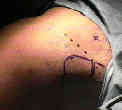- Position:
- beach chair position;
- position should allows full shouler extension, exernal and internal rotation (note that the posterior cuff will be brought into the operative field by extending and internally rotating the shoulder - which is acomplished by pinning the patient's arm between the OR table and surgeons hip while it is positioned in full exernal rotation;
- torso should be rotated slightly internally (away from surgeon) since this gives an "outlet view" of the shoulder and cuff;
- it is helpful to mark out the shoulder's bony landmarks before prepping and draping (avoid drape creep);
- Skin Incision: 
- incision is made parallel to Langer's Line, along lateral border of acromion and extends 4 cm anterior to the acromion (parallel to the lateral acromial edge);
- alternatively, an incision can be made similar to the one shown below;
- full thickness incision is made down to fascia, and then medial and lateral full thickness flaps are mobilized;
- leave the deltoid fascia undisturbed so that it can be used for secure closure at the end of the case;
- Periosteal Incision:
- the superficial dissection procedes down to the deltotrapezial fascia, at which time full thickness flaps are mobilized, leaving the fascia on the deltoid for later closure;
- deltoid "on" strategy:
- motivation for this technique is to avoid complete deltoid stripping off of the acromion;
- use cautery to make a full thickness fascial/periosteal incision from the posterior edge of the AC joint to the antero-lateral border of the acromion;
- use a knife or sharp periosteal elevator to elevate a full thickness perisoteal/fascia flap both medially and laterally;
- the deltoid is split down the anterolateral raphe, and subsequently sharpey's fibers are elevated "en mass" from either side of the anterior acromion, which allows the acromioplasty to procede without having to take down the deltoid off of the acromion;
- at the end of the case, the medial deltoid flap can be opposed down to the acromion with a non absorable suture passed through the acromion, and subsequently each edge of the deloid fascia/periosteal flap is opposed with interrupted suture;
- deltoid "off" strategy:
- motivation for this technique: the "Rockwood" anterior acromioplasty ends up leaving a sizable defect which needs to be re-secured with full thickness deltoid sutures;
- if the deltoid "on" technique (deltoid sparing) technique is used, then only dorsal deltoid fascia remains intact (which is weaker than a secure full thickness repair);
- cautery is used to start a full thickness fascia periosteal flap extending in a medial to lateral direction, starting at the lateral edge of the AC joint and extending directly laterally;
- it is important not to make this incision too far anteriorly since it will make it difficult to re-attach the deltoid at the end of the case;
- acromial branch of the thoracoacromial artery is coagulated;
- often it will be necessary to "dogleg" the peristeal flap incision posteriorly for additional exposure;
- a 15 blade scapel is then used to sharpley elevate the deltoid from its attachments on the anterior, lateral, and inferior aspects of the acromion;
- at the end of the case, it is essential that a secure deltoid repair be made;
- the full thickness substance of the deltoid is opposed to the raw surface of acromion, by passing No 2 ethibond sutures thru 2 or 3 drill holes made in the acromial surface;
- deltoid split:
- once the deltoid has been elevated off of the acromion (using either the "deltoid on" or "deltoid off" stratedgy), the incision is continued anterolaterally through the deltoid fibers (spliting them rather than transecting them);
- 5 cm incision is made between anterior parallel fibers of deltoid at its central multipennate origin;
- deltoid muscle arises in 3 parts, strongest being central multipennate origin from the lateral border and edge of the acromion;
- anterior & posterior origins, composed of long parallel bundles, arise from outer third of clavicle & from scapular spine, respectively;
- access to insertion of rotator cuff is obtained w/ minimum trauma to deltoid by dissection between the anterior and central origins
Massive, Irreparable Tears of the Rotator Cuff. Results of Operative Debridement and Subacromial Decompression.
Mini-Open Rotator Cuff Repair An Updated Perspective

